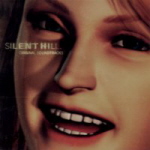Silent Hill Original Soundtracks
 |
Album Title: Silent Hill Original Soundtracks |
| Record Label: King Records |
|
| Catalog No.: KICA-7950 |
|
| Release Date: March 5, 1999 |
|
| Purchase: Buy Used Copy |
Overview
1999’s Silent Hill was created as Konami’s answer to Resident Evil. The story centered on a writer who crashed near the eponymous town, and his subsequent search for her. Along the way he gets involved with a cult that had helped to shape the town’s history. All of this is, of course, standard horror fare, but the treatment focused less on shock or gore and more on psychological atmosphere. The design of the town, covered in fog, helped to create the game’s world, but arguably more important to the game’s effect were the sound effects and score created by Akira Yamaoka, then a little-known composer at Konami with few lead credits to his name.
Body
Yamaoka, who volunteered himself for the job, handled both score and sound, and at times, the line between the two is blurred. Only a few of the tracks on the soundtrack have anything resembling a melody, and only a few more have clear harmonic structure. Many of them comprise only percussion or sound effects utilized percussively, as in industrial music. On album, many of the tracks are run together, and there is no doubt that the listening experience is carefully constructed from start to finish.
The soundtrack opens with “Silent Hill,” the music played over the opening FMV sequence, and it is one of the few melodic tracks on the album. Opening with a mandolin tremelo over electric guitar arpeggios, it combines elements of Morriconne with the 60s Bond scores by Barry, throwing them onto a trip-hop beat. The guitars are played with “wet” reverb, and the whole thing is recorded with a distinctively lo-fi, grainy sound that persists throughout much of the album. It’s a distinctive opening, and indicative in several ways of the direction the series’ music would take in later installments.
Following this introduction, “All” opens the main section of the album, the in-game ambient pieces. There is a slowly building soundscape, beginning with an echoing scraping sound, which repeats, as a clashing sound grows closer, like an approaching menace. Then it fades away into “The Wait,” a 9 second track comprising four brief synth chords, the last of which is quickly interrupted by “Until Death,” a pounding 7/4 ostinato pattern overlayed with elements in other meters. This usage of polymeter to signal chaos or confusion continues throughout the album, in “Devil’s Lyric,” the second half of “For All,” “Killed by Death,” “Half Day,” and so on.
Interrupting a quieter ambient piece with a full volume chaotic texture is a frequently employed strategy here to give the appearance of a continuous album, but not the only one. Often, a sound that is prominent in one track continues into the next one, like the roaring in “Killed by Death” and “Don’t Cry” or the unnerving screeching in “Not Tomorrow 2” and “My Heaven”. This latter is probably the most ear-splitting part of the entire album, and although it is startling or frightening, even apart from the game, its microtonal meandering is unbearable for long.
Although some of the soundtrack is entirely atmospheric noise or sound design, a good number of the middle tracks have at least some harmonic content, such as the echoing synth chords that resemble detuned chimes in “Claw Finger” or the voice effects on “The Bitter Season”, although these are used as part of a texture rather than as goal-directed progressions. The dense organ chords of “For All” are not very dissimilar from the clanging percussion of “Until Death”. But this only helps them to fit in with the rest of the album, as one realizes once the minimalist guitar and synth patterns of “Not Tomorrow 1” make their sudden appearance.
The next truly melodic track after the opening, though, is “Tears Of…”, which follows “My Heaven” as an antidote to its poison. Its blending of electric guitar and vibraphone with a trip-hop beat is indicative of the developed style of Yamaoka’s later scores for the series. Its intentionally lo-fi recording style extends into the next track, “Killing Time”, where the recording’s distortion and warping clash with the heavy reverb on every instrument. The bonus track, “Silent Hill (Otherside)” (which begins at 4:44), is also recorded in this way.
The main portion of the soundtrack concludes with “She”, a 70s rock influenced piece, replete with improvisational interjections from the lead guitar. It comes to a sudden close before fading in and then out again on a few arpeggiated guitar chords. On the original soundtrack release, this was followed by Rika Muranaka’s song “Esperandote”, but this is left off of the release in the Silent Hill Sounds Box and the digital iTunes release. The Spanish-language song, with its accordion and violin solos, has absolutely nothing in common with the rest of the soundtrack, and although the reason for its omission may be an issue pertaining to copyright, as some have assumed, the score is undeniably more consistent without it.
Summary
Silent Hill‘s score may not be as immediately appealing as its successors’, but it contains, in embryonic form, many of the elements that would come to define Yamaoka’s work for the series as a whole. The rock and trip-hop influences in the few melodic tracks would be revisited in later installments, and Yamaoka’s deft manipulation of sounds both synthetic and sampled in the ambient tracks would be put to ever more varied use later on. Despite the ambient tracks’ lack of melody and harmony in a traditional sense, there is something appealing about the album, and certainly something frightening, like a musical claustrophobia.
Do you agree with the review and score? Let us know in the comments below!
3.5
Posted on August 1, 2012 by Ben Schweitzer. Last modified on August 1, 2012.














